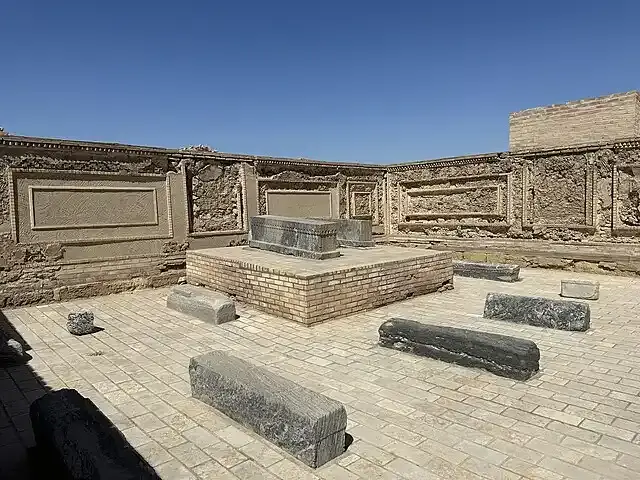Sayyeda Zeinab Shrine: A holy shrine with magnificent architecture
Located near Damascus, Syria, the shrine of Sayyida Zainab holds great importance as a religious place for Muslims in general and for Shiite communities in particular. It is considered one of the most prominent religious shrines in the Middle East, testifying to the deep dedication and reverence to Islam. In this article, we show the history of the shrine, its engineering and architectural specifications, its religious and cultural importance, and its current status.
Who is Sayyeda Zainab?

She is the granddaughter of the Messenger of Allah Muhammad (peace be upon him), the daughter of Imam Ali and Fatima (may Allah be pleased with them), and the sister of Imam Hussein, peace be upon him. Sayyida Zaynab, or Zaynab al-Kubra, was born in 626 CE in Medina, and was known for her piety, intelligence, and strong will, qualities that became most evident during and after the Battle of Karbala in 680 CE. This battle was a pivotal event in Islamic history, as her brother Imam Hussein and many of his followers were martyred. Sayyida Zainab played a crucial role in preserving the memory of Karbala and challenging the Umayyad authority through her powerful speeches and leadership. After the tragedy of Karbala, Sayyida Zainab was taken prisoner to Damascus, where she gave a famous speech at Yazid's court highlighting the injustice inflicted on her family. Sayyida Zainab is highly respected among Muslims for her role in preserving the teachings and legacy of the Prophet Muhammad and her unwavering resilience in the face of adversity.
Recommend
Date of the denominator:

The exact date of construction of Sayyida Zeinab is unknown, but the site has been revered by Muslims for centuries. It is believed that the mausoleum was created during the Middle Ages, perhaps in the eighth or ninth century, as a place to honor Sayyida Zeinab. Since then, the shrine has become a focal point for Muslim pilgrims, especially Shiites who revere Sayyida Zaynab as a symbol of resistance and faith. During Ottoman rule, the mausoleum of Sayyida Zeinab underwent major renovations and expansions. The Ottomans, who ruled Syria from the early sixteenth century to the early twentieth century, supported the maintenance of Islamic holy sites throughout their empire. The mausoleum was an important religious site, and the Ottomans made several efforts to strengthen its structure, add decorative elements and improve facilities for the growing number of pilgrims. In modern times the shrine has undergone further renovations. These efforts were aimed at accommodating the growing number of visitors, as the site became one of the most important pilgrimage destinations in the Muslim world.
The maqam has been managed by the Murtaza family since the fourteenth century. Many scholars and celebrities such as Sayyid Mohsen Amin Ameli and Sayyid Hussain Yusuf Makki Ameli were buried in the mausoleum of Sayyida Zainab and the surrounding tombs. Ali Shariati, one of the ideologues of the Iranian revolution, had wished before his death to be buried in Sayyeda Zeinab Square. His mausoleum is located inside the Sayyeda Zeinab mosque complex and is regularly visited by many Iranian pilgrims.
Religious and cultural significance:

The shrine of Sayyida Zeinab in the Damascus countryside is a magnificent religious site, highly respected by all Muslims. Thanks to its architectural splendor and historical significance, it serves as a place of pilgrimage, piety and spiritual nourishment, immortalizing the legacy of Sayyeda Zeinab and embodying the timeless values and traditions of Islam. But it is really not just a religious site, but also a cultural and social center for Muslims. It is particularly important during the commemoration of Ashura, the tenth day of the month of Muharram, which coincides with the martyrdom of Imam Hussein in Karbala. Pilgrims visit the shrine to offer their respects, participate in religious rituals, and seek spiritual consolation.
For Muslims in general and Shiites in particular, Sayyida Zainab represents steadfastness and struggle against tyranny. Her role in the wake of Karbala made her a respected figure, and her shrine is a symbol of the enduring spirit of the Ahl al-Bayt.
Current status of the denominator:

Today, Sayyeda Zeinab remains an active site to visit, restoration efforts have been made to repair recent damage, and the shrine continues to attract visitors from all over the world, especially during important religious occasions. The site is home to a mosque where regular prayers and special religious ceremonies are held, especially during the month of Muharram. But the significance of the mausoleum extends far beyond its religious significance; it has become a symbol of steadfastness, reflecting the enduring legacy of Sayyida Zainab and the broader struggle for justice and faith in Islamic history.
The Sayyida Zeinab shrine near Damascus is more than just a historical landmark; it is a living symbol of faith, resistance and cultural identity for millions of Muslims around the world. Its rich history, spanning centuries, reflects the deep respect for Sayyida Zainab and the profound influence she has had on Islamic history.
Its impact extends far beyond Syria. It serves as a beacon of faith, attracting millions of believers who find solace and inspiration in Sayyida Zainab's dedication and legacy, and stands as a testament to the enduring power of religiosity and spiritual heritage of one of Islam's most revered women.
![]()
A book that may interest you: pistachio theory
A book that might interest you - Pistachio Theory more- ADVERTISEMENT
![]()
Due to lack of funding, old NASA may be on an unsustainable path
Underfunded, aging NASA may be on unsustainable path more- ADVERTISEMENT
![]()
The real signs of a very intelligent person
True Signs of a Highly Intelligent Person more- ADVERTISEMENT
![]()
Real books prominent in self-development - including by an Arab specialist
Tired of theory-heavy self-help books? Try these three practical ones instead: Emma Bauer’s guide builds strong human connections with real-life tips, Mohamed Taha’s poetic book inspires change with depth and emotion, and Stéphane Garnier’s fun take shows how cat behavior can teach us joy, confidence, and better relationships. more- ADVERTISEMENT
![]()
Things people with emotional intelligence never do
Emotional intelligence helps people understand and manage emotions, leading to better relationships, improved teamwork, and stronger mental health. It can be developed through self-reflection, mindfulness, and active listening. Emotionally intelligent people avoid impulsive actions and build balanced lives with better decision-making and communication. more- ADVERTISEMENT
![]()
Does pregnancy accelerate "biological aging"?
A study in the Philippines found that pregnancy may speed up biological aging in women, with each pregnancy linked to about 4 to 4.5 months of aging. This effect wasn't seen in men, and varied depending on context. Researchers hope these insights might guide future anti-aging treatments. more- ADVERTISEMENT
![]()
The Genius of Nature: 8 Amazing Technological Innovations Inspired by Nature
Nature inspires some of the coolest tech—like butterfly wings improving solar cells or kingfishers helping trains go quiet and fast. Even surgical needles got less painful thanks to mosquitoes. From firefly-inspired LEDs to Velcro born from prickly plants, the wild world is secretly shaping our everyday innovations. more- ADVERTISEMENT
![]()
Empires that changed the world
The Persian Empire ruled nearly half the world’s population, setting the gold standard for future empires. The Romans blended conquest with culture, inspiring modern democracy. The Mongols, though few, built the largest land empire through sheer mobility. The British shaped today’s world through trade, law, and global influence. more- ADVERTISEMENT
![]()
Success Guide - How to Learn Project Management?
Success Guide - How to Learn Project Management more- ADVERTISEMENT
![]()
Scientists wonder if the universe looks like a donut cake
Scientists are exploring the universe’s shape and structure, searching for signs of cosmic loops and mirrored galaxies. Using improved CMB maps and powerful telescopes, they aim to uncover if the universe is finite—and perhaps one day map it all, like a cosmic version of Google Earth. more- ADVERTISEMENT





















